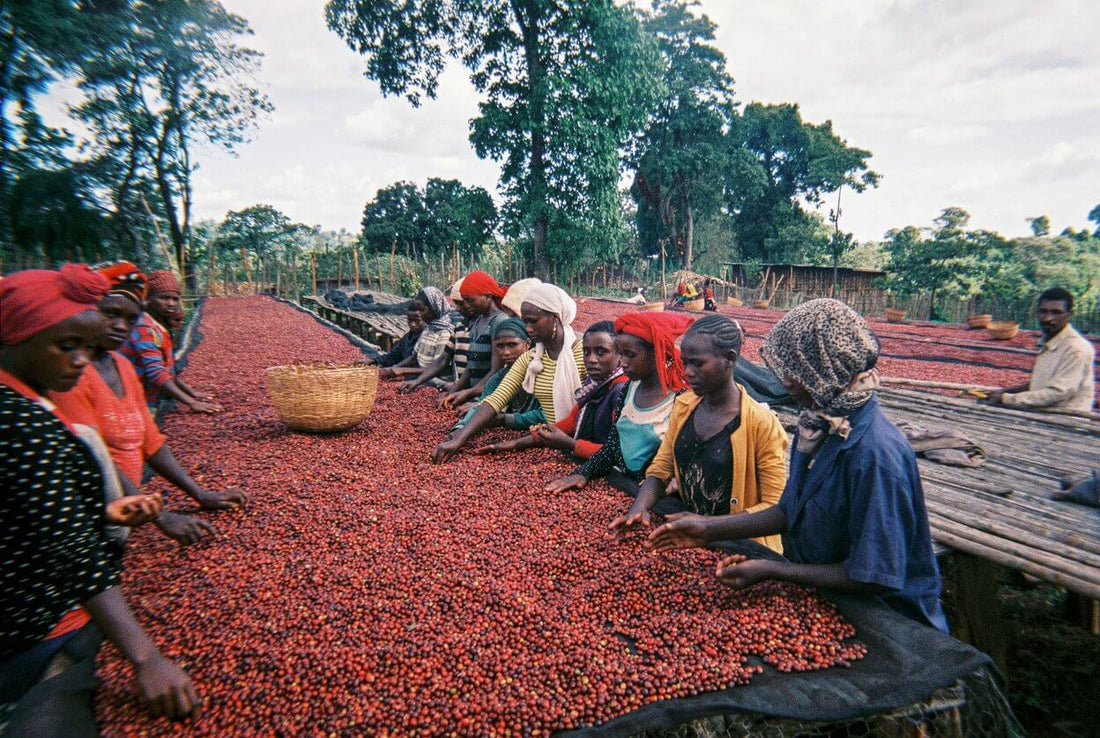
SINGLE ORIGIN ETHIOPIA WONBERTA WASHED
Our procurement strategist Lucy Ward is a seasoned buyer, with extensive experience both in the cupping lab and in the field. She is a qualified Q grader, Q Grader Assistant Trainer, and travels to origin to inspect, evaluate, and purchase green beans, nine months out of the year.
In December of last year, Lucy flew to Ethiopia for a three-week sourcing trip. At the end of her first day she arrived in Chelelektu, checking out the Boji washing station in Kochere (Kochere is a woreda – basically a district). Ethiopia has very loose regions and such, but Chelelektu is a town in the district of Kochere in the state of Yirgacheffe. After this, they drove from Chelelektu to Hambela (a washing station) in Guji.
This was a massive drive. In getting there, the team had to drive for over four hours, under 20km per hour, through roads so carved up occasionally they had to get out of the vehicle to lighten the load, raising the 4-wheel drives clearance. Their driver, in Lucy's words "was basically an Ethiopian Crocodile Dundee, slightly on edge, who wore a leather vest and chewed Chat the whole way there."
To get to Hambela, they drove through Gedeb and then Diimtuu. The road from Diimtuu to Hambela was probably the worst they had been on yet. Reduced speed further they had to weave through waves of dirt, potholes as deep as cars, and trenches as deep as Lucy was tall. All of these were the aftermath of the massive Soviet-era trucks that do supply and equipment runs through the area.
They finally pulled in at around 9pm, exhausted and covered in dust from days of being on the road. They guys at the wash station had set up a cluster of tents for us on the drying patio with a bonfire in the center. After they found their tents, Lucy and the team put their bags down, visited the pit toilet on the edge of the forest, and tried to wash themselves down as best they could with bottled water. Gathered around the fire afterward the crew brought out corn on the cob, fresh from the coals, starchy, charred, and satisfying. For mains, a bowl of bean soup was served with a big helping of fried goat and a spinach dish riddled with beans. All naturally served with Injera and yeasty bread.
Finally, they bedded down for the night deep in the heart of Guji, to the sound of coffee being pulped late into the night. "It was a rather surreal experience," says Lucy.
The next morning they were up early again—another big day with a lot to do. The end destination for the day was Gurache, directly on the other side of the Mormora river from where they were now. There are no bridges, and the roads are terrible so it takes a long time. After a light breakfast of bread, jam, and a lot of coffee, they all jumped in the Toyotas and hit the road.
By 11am they were passing the Diimtuu washing station and stopped for some food in town. Lunch was in the back of a butchers shop past a makeshift bar, in a dingy, dark room with sticky black floors strewn with grass in the traditional Ethiopian manner. They found a table in the back corner, plastic chairs scattered around a small table coated in peeling vinyl pressed up against the mud and straw walls. It was dark and dank, but the food here was tasty and filling. Cold Cokes and hot trays abundant with Tibbs and kocho (a local bread) came out quickly, and they ate with their hands heartily until stuffed full.
Next stop was the Gannett station, one of the washing stations from the Wonberta operation. Wonberta has four locations around the place, this being one of the bigger ones. Here the parchment is skin dried in thin layers and thickened up as the drying progresses. The workers here are super controlled, keeping the lots separate by collection station throughout the processing. The coffee here was a small screen size which was quite weird, looking to be 100% below 15scr. They had been buying cherry for 10 days by the time Lucy visited, so she was early in the season, and perhaps this was the reason for the small size.
The manager Tesfaye invited Lucy and the team in for some buna. "It was very decent," says Lucy. "We chatted about the operations and harvest so far while we drunk but most of it was in Amharic, so I was out of my depth."
He suggested they drop into Ketooma station just up the road, another of the Wonberta locations. Ketooma means “it's yours” in Oremo language. This smaller site is located at 2100 masl, meaning at this height drying will be quite slow. When Lucy arrived, they were receiving cherry in a small hut by the beds. The ponies and donkeys would trot in laden with bags tied to their sides with false banana leaf. Men would step in on each side as the animal arrived, unstrapping the false banana “rope” and letting the heavy sacks fall to the ground. This often alarmed the ponies, followed by their obvious relief as they shook it off before trotting away to find a green blade of grass while their owner waited to receive payment, about 9-10 birr a kilo for cherry.
They had one more Wonberta station to hit up before they lost light, heading up the road to Sari Saba where the place was in full swing. The beds were laden deep with drying parchment and the collection point for cherry was a mad bustle as ponies and donkeys streamed in. Lucy wove in between the small children, fighting animals and shouting men to get a clear view of the chaos of the scales.
The men here are all busy on the washing channels, collecting the coffee and dumping the wet parchment on the beds. The women work in clusters around the beds, rotating the beans and cleaning the debris, a hard job when the beds in the skin drying stage here are so full, about 20cm deep. On this day capacity was clearly a concern at the station as there are no more beds left. It sounded like they are looking at moving some of the coffee to the other stations just to dry it all in time. Apparently, the whole Wonberta group produces 80 to 100 boxes a year, and 50 of these go to Nespresso.
At ST. ALi we were lucky enough to grab some of this delicious coffee ourselves. You should really try some for yourself.



